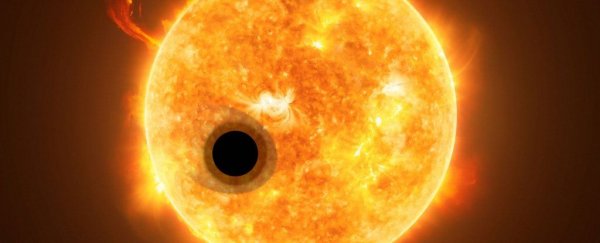The discovery of multiple exoplanets that appear to be shrinking appears to resolve a 'missing link' in planetary evolution.
Four mini-Neptunes in close proximity to their stars have been found leaking their atmospheres at a rate consistent with eventual total loss. This suggests that these worlds will eventually shrink into terrestrial, roughly Earth-sized planets – and moreover, it's the fault of their stars that they will do so.
Although scientists have long thought that these two types of exoplanets were linked, the pathway by which the mini-Neptunes lost their atmospheres was unknown.
While other mechanisms might still be at play, the newly identified shrinking worlds suggests that stripping by way of stellar irradiation is a leading one.
The Milky Way galaxy is a big, diverse place, and there are many kinds of exoplanets that have been identified to date that are very different from what we find in our own Solar System. One of those is the mini-Neptune – the most common kind of world detected by the Kepler mission, but notably absent from our own little corner of the galaxy.
These are worlds that are more massive than Earth, and less massive than Neptune, but still shrouded in a Neptune-like thick atmosphere of hydrogen and helium. Interestingly, these exoplanets seem to get no smaller than around twice the radius of Earth.
Super-Earths are the next category down, exoplanets that are between 1 and 1.5 times the radius of Earth. Between around 1.5 and 2 Earth radii, there's a curious gap in which exoplanets are extremely scarce. This is known as the small planet radius gap.
Scientists believe that this gap exists because, above a certain critical limit, exoplanets have enough mass to retain a substantial primordial atmosphere that inflates their size, putting them in the class of mini-Neptunes. Super-Earths, on the other hand, don't have enough mass, and either lost their primordial atmospheres, or never had them to start with.
The next question is then if these exoplanets started out with primordial atmospheres, how did they get lost?
One potential pathway, called core-powered mass loss, is the internal heat resulting from planetary formation, in which gravitational binding energy is converted into heat that ejects the primordial atmosphere. The other is called photoevaporation, in which intense X-ray and ultraviolet irradiation from the young star strips away the exoplanet's atmosphere.
Determining which of these scenarios leads the transformation of mini-Neptunes into super-Earths requires observing leaking exoplanets, and determining the rate at which they are losing mass.
This brings us back to a new paper, from a team of researchers led by astronomer Michael Zhang of the California Institute of Technology (Caltech). They used spectroscopy to study the atmospheres of four young, nearby mini-Neptunes orbiting orange dwarf stars, to determine the rate at which these exoplanets are leaking helium into space.
These four mini-Neptunes include one called TOI 560b, which has a radius 2.8 times that of Earth's, the analysis of which was published by Zhang and his colleagues earlier this year.
The other three are new: TOI 1430.01, at 2.1 times the size of Earth; TOI 1683.01, at 2.3 times the size of Earth; and TOI 2076b, at 2.52 times the size of Earth.
All four planets had significant helium outflows, the team found, at a rate consistent with photoevaporation, rather than core-powered mass loss. In addition, this loss rate is sufficient to strip the atmospheres of these exoplanets in just a few hundred million years, the team found – that's a pretty short timescale in cosmic contexts.
The team says their findings suggest that most mini-Neptunes orbiting Sun-like stars probably turn into super-Earths, and do so via photoevaporation.
"We conclude that many, if not all, of these planets will lose their hydrogen-rich envelopes and become super-Earths," Zhang and colleagues write in their paper, which awaits peer review.
"Our results demonstrate that most mini-Neptunes orbiting Sun-like stars have primordial atmospheres, and that photoevaporation is an efficient mechanism for stripping these atmospheres and transforming these planets into super-Earths."
The research has been submitted to The Astronomical Journal, and is available on arXiv.
